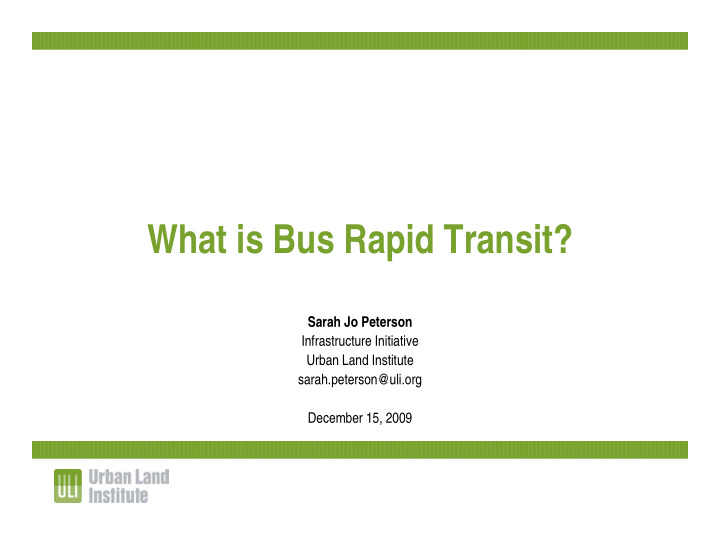



What is Bus Rapid Transit? What is Bus Rapid Transit? Sarah Jo Peterson Infrastructure Initiative Urban Land Institute sarah.peterson@uli.org sarah.peterson@uli.org December 15, 2009
Is Bus Rapid Transit … p • Bus lines that work like rail lines? il li ? • Buses in car pool lanes? • Bus-only corridors or busways? • Buses that, like magic, B th t lik i almost always hit green lights? lights? EmX BRT Line in Eugene-Springfield, Oregon
YES! YES! Clockwise starting top right: Pittsburgh busways; interior of Orange Line bus, Los Angeles; Curitiba, Brazil BRT station; Illustration of expressway BRT in suburban Chicago
What is BRT? The Technical Definition … A flexible, high performance rapid transit mode that combines a variety of physical mode that combines a variety of physical, operating and system elements into a permanently integrated system with a p y g y quality image and unique identity. Federal Transit Administration/National BRT Institute, 2009
Bus Rapid Transit is a not a type of bus; it ’ s a new way of thinking about bus service f thi ki b t b i • Applies creativity and innovation to metropolitan bus service • • Focuses on medium-length and longer trips Focuses on medium-length and longer trips – Need time savings to compete with the automobile – Need comfort and ease to compete with the automobile • Federal government helps fund through Very Small Starts, Small Starts, New Starts • Parallel movement: applying creativity and innovation to local trips that maximize access : – Urban circulators and trolley buses – Does not yet have a name as sexy as BRT Does not yet have a name as sexy as BRT – New federal funding pot announced by the Obama administration 12/1/2009
BRT: Areas Undergoing Innovation g g • Running ways or corridors • Stations • Vehicles • Fare collection • Intelligent Transportation System technologies including Transit Signal Priority • Service and operations • Branding
BRT and Land Use: The Possibilities? • Is there such a thing as BRTOD? Maybe. • Is there such a thing as BRT-supportive development? YES! • • BRT ’ s strengths are also its challenges for land development BRT ’ s strengths are also its challenges for land development – New and evolving – Variability – Phasing Ph i • Decisions about corridors and stations are typically the most important – The more significant the infrastructure investment or dedication, th the more likely it is to shape development lik l it i t h d l t • Coordination with land use – Regional corridor level – Local corridor access or station level – Context dependent
Recommend
More recommend